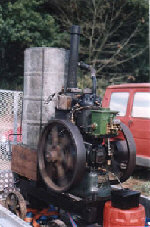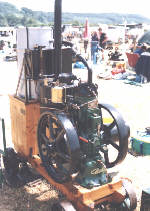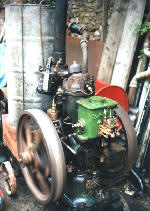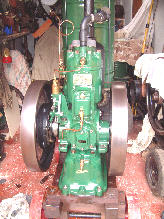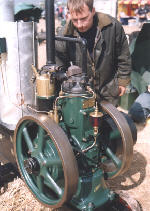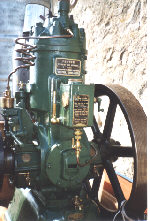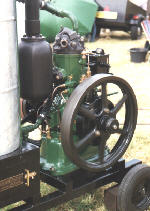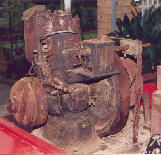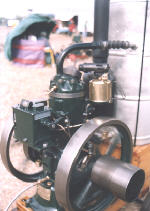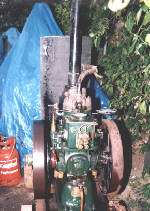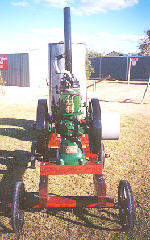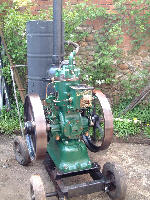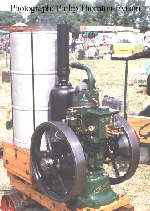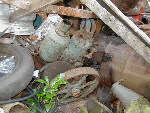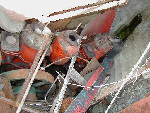The History and development of the 5 and 8hp Petter S type Oil engines - (or musings of a Petter nut!) The author would like to thank the following for their help: Dave Shortland, Philip Thornton-Evison, Colin Purchase. All content © Roland Craven unless noted otherwise. |
||
|---|---|---|
Whole engines: #32712 The earliest 5hp so far.(Owner Richard Keyte)
#32856 Built August 1923. Sold 18 October 1923. Rebuilt by Petter in November 1929. Then sold to "Post als" (whatever that means?) Note the early style oil pot.
#32859 happily chuffing in the shed
#33425 Clearly showing the wineglass oiler and undrilled base (Owner Colin Purchase )
#34767 8hp of 1925(All photographs of this engine courtesy of Len Ralph). Note the shrink ring on the top of the crankcase - a standard technique then. This crankcase also has an unusual boss cast in low on the governor side. (Owner Andy French)
#35969 A beautiful example of a single feed Madison with the unusual lift pump. Sold on 9 December 1925 (Owner Philip Thornton-Evison)
and a fine example of a generator engine (owned by Mick Christie in Australia) #38303 from December 1926. A fine example of a twin feed Madison engine and also showing the uncommon correct "Governer" blowlamp. (Owner Dave Shortland)
#202622 an example of a Calibrater model from 10 September 1928. Returned to the works and rebuilt in January 1931. Note the separate oil wells on the main bearings.(Owner John Ambler)
and here is a nice one from Australia #205990 (Owner Russell Gilbert)
#211553 of 8.75hp @600rpm. Casting date 1934, Yeovil built in 1935 and sold in 1936.
#213029 of 6hp. A fine example of a late, Loughborough, model from 1937. (Once owned by Dave Shortland)
and for a bit of fun. How many S type engines and components can you find in these pictures? |
Manufacture
of these beautiful engines began in 1923 and the design underwent several stages of
evolution before its withdrawal in 1940. Less than 30,000 were made. Power output began at
5hp (550rpm) and was later increased to 6 hp (600rpm). The bore/stroke and many components are shared with the 5hp M type.Initial production was at Yeovil with the switch to Loughborough in about 1936 at which time the word Yeovil disappears from the nameplate. In general Loughborough engines are painted grey and have reference to Yeovil somewhat crudely ground out. As always these comments are generalisations not rules. Most of the changes occurred in the early years with few modifications after the Calibrater version appeared in 1927. For the purposes of this paper I shall regard the, approximately 7000, pre-Calibrater engines as “early”. Initially it was titled the "Petter Crude Oil Engine" with the first believed to be serial number 32580. It is not known exactly when this name was replaced by "S Type Oil Engine" although this did happen at or before engine #34767 (for the 8hp at least). In many ways it seems to be a scaled down type VC (#31203 - Owner Anthony Harcombe) but was actually preceded by the very rare type VB "Junior 8". (details of this may be found in SEM 246 and 252 - an instruction book is available from Patrick Knight. These musings are based on a small sample some of which could well have been altered. Early engines are rare in original form as many were returned to the works and rebuilt to later standards. This makes tracking the development very difficult and the author welcomes contributions and especially photographs. The many detail changes are set out below (Click the links for detail pictures then use your back button to return).
Notes on casting dates: Usually, but not always, these may be found, in DDMMYY format, cast just inside the rear reed valve housing aperture. As was normal practice then castings were typically aged for about six months before they were machined. However gaps of many years are known between casting and build dates. The spray pump cam roller-shaft must always been prone to wear and around 1930 Petter added an additional lidded wick-oiler above the fuel priming handle. This discharges through a copper pipe onto the roller pin and the excess lubricates the roller itself. The pump bracket was modified to provide a mounting point. The earlier wick oilers were cast brass but were later changed to cast aluminium no doubt as the new skills were acquired for the A1. At about the same time the fuel filler cap and fuel filter were also changed to cast aluminium. Finally a puzzle. Engine 32859 (5hp) has a variety of part numbers including; five digit numbers in the 20,000 range, VF, VB and VFB.One might assume that these were shared with the 5hp M type (VF) and the 8hp M type (VB). However the governor housing of #32859 has a cast in part number beginning VB. Clearly this cannot have been shared with the big M and later housings do not carry this number. Could it be that the big M was intended to be a compression ignition engine, or direct injection at any rate, and was released in its familiar form only as a stopgap? It was certainly dropped as soon as the 8hp S type was in production and the VS designation applied to the S type seems to appear only in later records. Might it be relevant that the later Hamworthy engines from the same designer are direct injection and use a similar governor?
|
